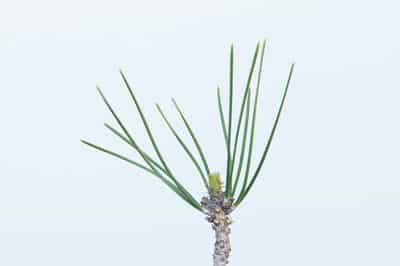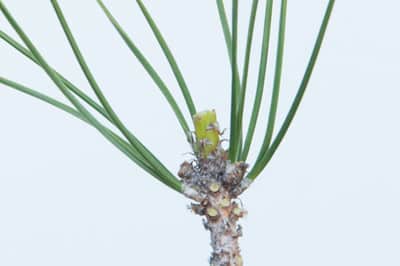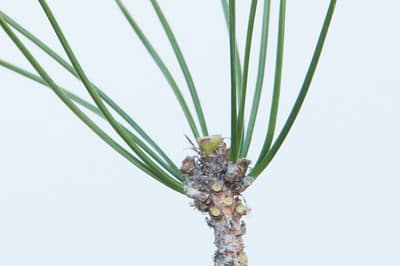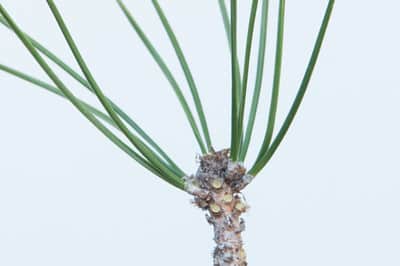So far we have covered techniques for controlling the vigor of summer shoots for an entire bonsai. Today we’ll look at three techniques for controlling vigor branch by branch. One of the greatest benefits of decandling is the ability to weaken strong branches and improve the vigor of weak branches. It is through the successful application of these techniques that well-balanced pines are developed.
How do I control the vigor of individual branches?
There are three main techniques for controlling the vigor of individual branches:
- Pulling needles
- Leaving stubs
- Decandling different branches at different times
Having decided to decandling a given branch, we first remove the spring shoots.

Spring shoots

Spring shoots removed
To further reduce the vigor of this branch, we can take the first approach noted above and remove some of last year’s needles.

Before pulling needles

After pulling needles
How many needles we can pull or leave depends on how many needles we started with, the relative vigor of the branch and the general approach to decandling. The range is often between three and twelve pairs per branch. I’ll say more about needle pulling work when we cover fall work.
The second approach to reducing vigor involves leaving a stub at the base of the candle. Leaving a stub preserves tissue that produces auxins, the hormones that apical buds use to slow down the development of adventitious and lateral buds. The longer the stub, the more auxins, and the slower the adventitious buds are to develop. Simply put, long stubs slow down the development of summer shoots.
How long should the stubs be?
A common approach to leaving stubs is to leave long stubs on strong shoots, small stubs on weak shoots, and medium-sized stubs on medium-vigor shoots.
- Strong shoots – stub length is about 2x diameter of shoot, often between 1/4″ – 1/2″
- Medium shoots – stub length is about 1x diameter of shoot, often between 1/8″ – 1/4″
- Weak shoots – stub length is about 1/2x diameter of shoot, often between 1/16″ – 1/8″

Long stub

Medium stub

Small stub
The third approach to the reducing vigor of individual branches is to decandle weak shoots early and more vigorous shoots later. We know that the earlier we decandle a tree, the longer the summer shoots will have to grow. By removing spring growth from the weakest shoots first, we give the summer shoots on these branches a head start over the branches that will be decandled later.
I’ll leave some time for this to sink in and will give the topic further attention next week when we look at some common approaches to for decandling.
Subscribe to Bonsai Tonight
New Posts Delivered Every Tuesday and Friday
Mark says
Very nice series! Thanks!
Do you plan to write similar lectures for other pine species. I’m particularly interested in Scots pine / Pinus sylvestris.
Jonas Dupuich says
Hi Mark – I’ll happily write what I can about other species of pine but it won’t be very much as I don’t know much about them (I don’t see a lot of Scots pine bonsai in Northern California). Will see what I can do! Jonas
Chris Cochrane says
Stubbing (peg & neck) practice & alternatives– a great review & polishing of info. Thanks.
Brian says
Jonas
Well done. Very clear, easy to understand . With your last article on pines would you please put all of your info on one page so we can have all off your articles on spring pine care in one easy to understand spot. So good.
Thanks Jonas
Qualicum Brian
bruwno says
great stuff
thank you
bruno
Bonsai junkie says
Great piece Jonas, you have a talent for explaining techniques that is understandable and sinks into the memory banks.
Thank you and please keep up the hard work
Tim